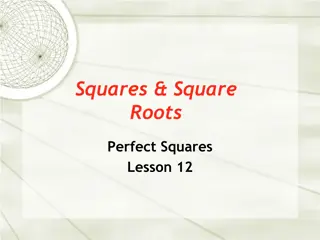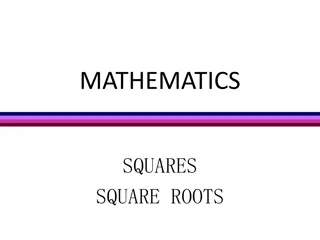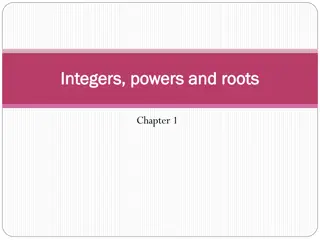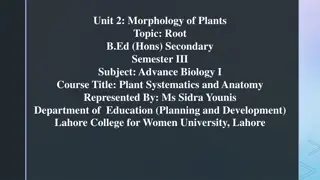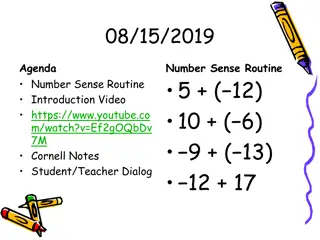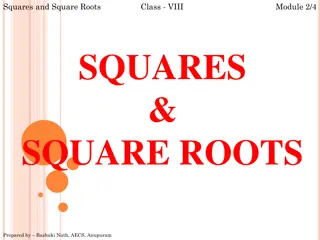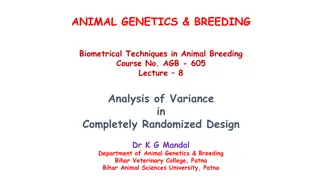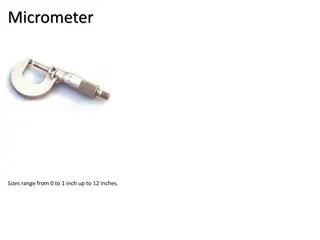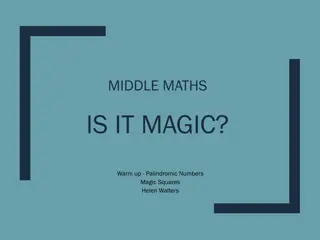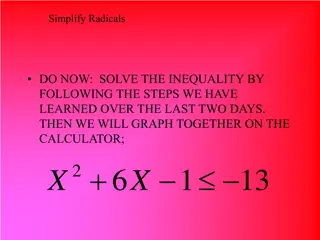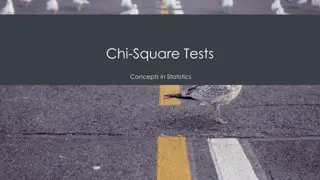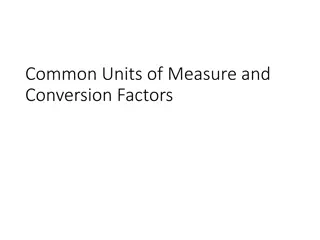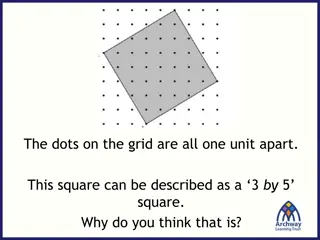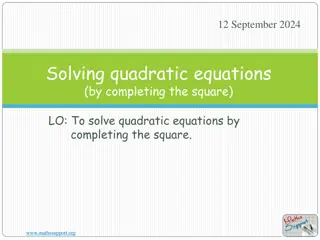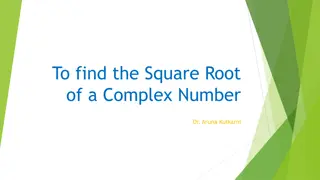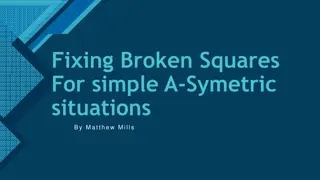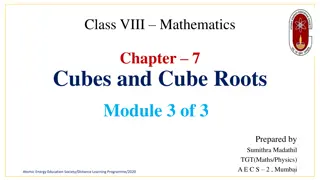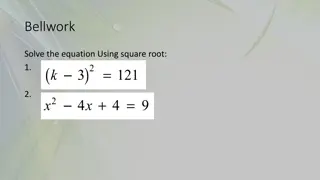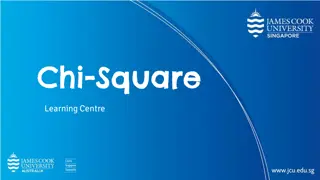Understanding Squares and Square Roots
Explore the concept of squares and square roots in this informative module for Class VIII. Discover how to find the area of a square, recognize square numbers, and understand properties of square numbers. Enhance your knowledge of perfect squares and the patterns they follow. Dive into the world of mathematical squares with this engaging resource by Bashuki Nath from AECS, Anupuram.
Download Presentation

Please find below an Image/Link to download the presentation.
The content on the website is provided AS IS for your information and personal use only. It may not be sold, licensed, or shared on other websites without obtaining consent from the author. Download presentation by click this link. If you encounter any issues during the download, it is possible that the publisher has removed the file from their server.
E N D
Presentation Transcript
Squares and Square Roots Class - VIII Module 1/4 SQUARES & SQUARE ROOTS Prepared by Bashuki Nath, AECS, Anupuram
Squares and Square Roots Class - VIII Module 1/4 We know that the area of a square = side side The table for the area of a square with given side Side of square (in cm) 1 2 3 4 5 Area of square (in cm2) 1 1 = 1 = 12 2 2 = 4 = 22 3 3 = 9 = 32 4 4 = 16 = 42 5 5 = 25 = 52 Side of square (in cm) 6 7 8 a x Area of square (in cm2) 6 6 = 36 = 62 7 7 = 49 = 72 8 8 = 64 = 82 a a = a2 x x = x2 Prepared by Bashuki Nath, AECS, Anupuram
Squares and Square Roots Class - VIII Module 1/4 Such numbers like 1, 4, 9, 16, 25, 36, 49, ... are known as square numbers. Prepared by Bashuki Nath, AECS, Anupuram
Squares and Square Roots Class - VIII Module 1/4 In general, if a natural number m can be expressed as n2, where n is also a natural number, then m is a square number or perfect square. Example 25 = 52, here 25 can be expressed as 52, so 25 is a square number. Prepared by Bashuki Nath, AECS, Anupuram
Squares and Square Roots Class - VIII Module 1/4 Properties of Square Numbers Property 1 All the square number end with 0, 1, 4, 5, 6 or 9 at unit place. None of these end with 2, 3, 7 or 8 at unit s place. Prepared by Bashuki Nath, AECS, Anupuram
Squares and Square Roots Class - VIII Module 1/4 Properties of Square Numbers Property 2 The one s place of square depends on the one s place of the numbers. The one s place of square is 1 for the numbers ends with 1 & 9. The one s place of square is 4 for the numbers ends with 2 & 8. The one s place of square is 9 for the numbers ends with 3 & 7. The one s place of square is 6 for the numbers ends with 4 & 6. The one s place of square is 5 for the numbers ends with 5. The one s place of square is 0 for the numbers ends with 0. Prepared by Bashuki Nath, AECS, Anupuram
Squares and Square Roots Class - VIII Module 1/4 Properties of Square Numbers Property 3 If a number contains some zeros at the end, its square have double zeros. In 500, two zeros are there & in the square of 500 = 250000, four zeros. Prepared by Bashuki Nath, AECS, Anupuram
Squares and Square Roots Class - VIII Module 1/4 Properties of Square Numbers Property 4 Total natural numbers between two consecutive squares is double of the smaller number Between 152 and 162 there are thirty (15 2 = 30) non square numbers. Prepared by Bashuki Nath, AECS, Anupuram
Squares and Square Roots Class - VIII Module 1/4 Properties of Square Numbers Property 5 Total natural numbers between two consecutive squares is one less than the difference of the squares. Between 81 and 64 there are sixteen {(81 - 64) 1} non square numbers. Prepared by Bashuki Nath, AECS, Anupuram
Squares and Square Roots Class - VIII Module 1/4 Properties of Square Numbers Property 6 If the result is zero on successive subtraction of odd natural numbers starting from 1 (1, 3, 5, 7, ..) from a number, then the number is a perfect square. Consider the number 25. Now Successively subtract 1, 3, 5, 7, 9, ... from it. 25 1 = 24, 24 3 = 21, So, 25 is a perfect square. 21 5 = 16, 16 7 = 9, 9 9= 0 (zero) Prepared by Bashuki Nath, AECS, Anupuram
Squares and Square Roots Class - VIII Module 1/4 Properties of Square Numbers Property 7 The sum of first n odd natural numbers is n2. Sum of first 18 odd numbers = 1 + 3 + 5 + 7 + 9 + = ? = 182 Prepared by Bashuki Nath, AECS, Anupuram
Squares and Square Roots Class - VIII Module 1/4 Properties of Square Numbers Property 8 We can express the square of any odd number as the sum of two consecutive positive integers. 212 = 441 = 220 + 221 Prepared by Bashuki Nath, AECS, Anupuram
Squares and Square Roots Class - VIII Module 1/4 Some patterns in square numbers 12 = 1 112 = 1 2 1 1112 = 1 2 3 2 1 11112 = 1 2 3 4 3 2 1 111112 = 1 2 3 4 5 4 3 2 1 111111112 = 1 2 3 4 5 6 7 8 7 6 5 4 3 2 1 Prepared by Bashuki Nath, AECS, Anupuram
Squares and Square Roots Class - VIII Module 1/4 Some patterns in square numbers 72 = 49 672 = 4489 6672 = 444889 66672 = 44448889 666672 = 4444488889 6666672 = 444444888889 Prepared by Bashuki Nath, AECS, Anupuram
Squares and Square Roots Class - VIII Module 1/4 You also try to find some more properties and patterns on square of numbers and discuss with your teachers. THANK YOU Prepared by Bashuki Nath, AECS, Anupuram


